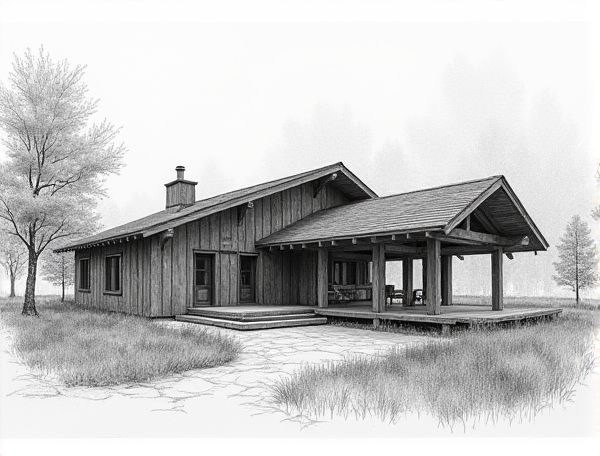
Photo illustration: Wabi-sabi home design with reclaimed barn wood
Incorporating reclaimed barn wood into your Wabi-sabi home design creates a unique blend of natural imperfection and rustic charm that enhances the warmth and authenticity of your living space. Discover how this sustainable choice brings character and tranquility to your home by reading more in the article.
Introduction to Wabi-Sabi Home Design
Wabi-Sabi home design embraces the beauty of imperfection, natural materials, and simplicity, highlighting rustic textures and asymmetrical forms inspired by Japanese aesthetics. This approach fosters tranquility and authenticity by celebrating the passage of time and the unique character found in hand-crafted, weathered elements.
Embracing Imperfection in Interior Spaces
Embracing imperfection in interior spaces creates a warm and authentic atmosphere where your personality truly shines. Wabi-sabi design principles highlight natural textures, asymmetry, and lived-in charm, making each room uniquely inviting. By valuing organic flaws and irregularities, you transform your home into a space of comfort and genuine beauty.
The Appeal of Reclaimed Barn Wood
Reclaimed barn wood offers unmatched character and sustainability in home design, featuring unique textures and rich patinas developed over decades. Its eco-friendly nature reduces waste while providing a warm, rustic aesthetic that complements modern and traditional interiors alike. This versatile material enhances walls, furniture, and flooring with a distinct historical charm that adds depth and authenticity to any space.
Harmonizing Nature and Simplicity
Incorporating natural materials and minimalist design principles enhances the harmony between your living space and the environment. Organic textures, neutral color palettes, and ample natural light create a serene atmosphere that promotes tranquility and well-being. Your home becomes a seamless extension of nature, balancing simplicity with sustainable elegance.
Textural Contrast: Rough Wood Meets Soft Furnishings
Incorporating textural contrast in home design enhances the sensory experience by pairing rough wood elements with soft furnishings to create dynamic visual interest. The tactile roughness of reclaimed oak beams or distressed wooden floors balances effortlessly with plush velvet cushions or smooth linen upholstery. You can elevate your interiors by blending these opposing textures, adding depth and warmth to every room.
Sustainable and Mindful Material Choices
Selecting sustainable and mindful materials like bamboo, reclaimed wood, and low-VOC paints significantly reduces environmental impact while promoting healthier indoor air quality. Your home design can incorporate energy-efficient insulation and recycled metal fixtures to enhance durability and resource conservation. Emphasizing eco-friendly choices supports long-term sustainability and creates a nurturing living environment for your family.
Creating Tranquil Spaces with Natural Light
Maximize natural light in your home design to enhance tranquility and promote well-being by strategically placing large windows and using light-reflective surfaces. Incorporate elements such as sheer curtains and skylights to diffuse sunlight softly, creating a serene and inviting atmosphere. Your tranquil space benefits from integrating natural illumination that harmonizes with organic materials and calming color palettes.
DIY Ideas Using Reclaimed Barn Wood
Transform your living space with DIY ideas using reclaimed barn wood that add rustic charm and sustainable character to your home design. Incorporate this versatile material into furniture, accent walls, or shelving to enhance your decor while promoting eco-friendly practices.
Preserving History and Character in Modern Homes
Incorporating original architectural details such as crown moldings, exposed beams, and vintage fixtures preserves the historical essence while seamlessly blending with contemporary design elements. Your home maintains its unique character and timeless appeal by balancing restoration with modern functionality.
Tips for Achieving Authentic Wabi-Sabi Aesthetics
Incorporate natural materials like wood, stone, and clay that showcase organic textures and imperfections to achieve authentic Wabi-Sabi aesthetics. Emphasize simplicity, asymmetry, and weathered finishes to create a serene, imperfect beauty reflecting the philosophy's focus on impermanence and authenticity.
 homedesy.com
homedesy.com